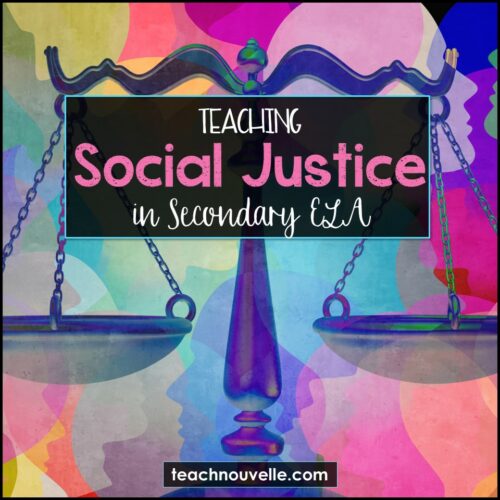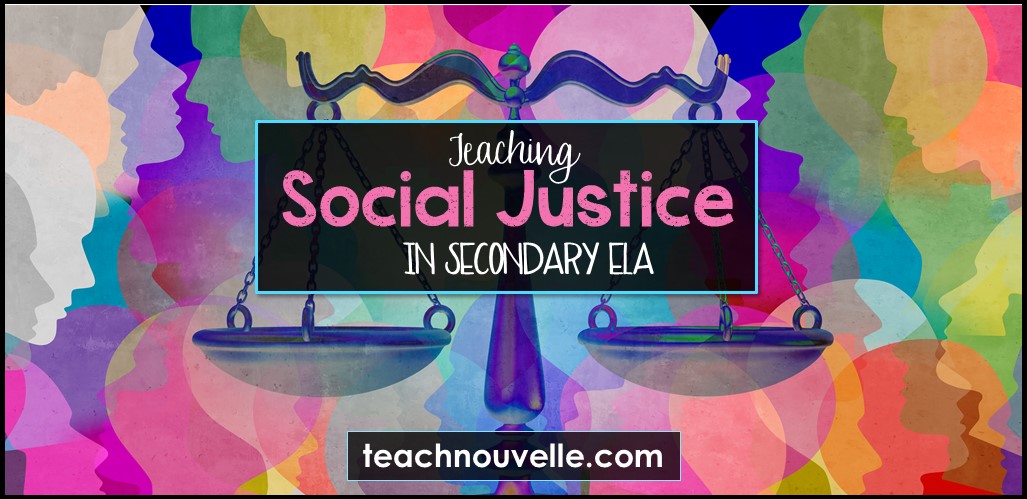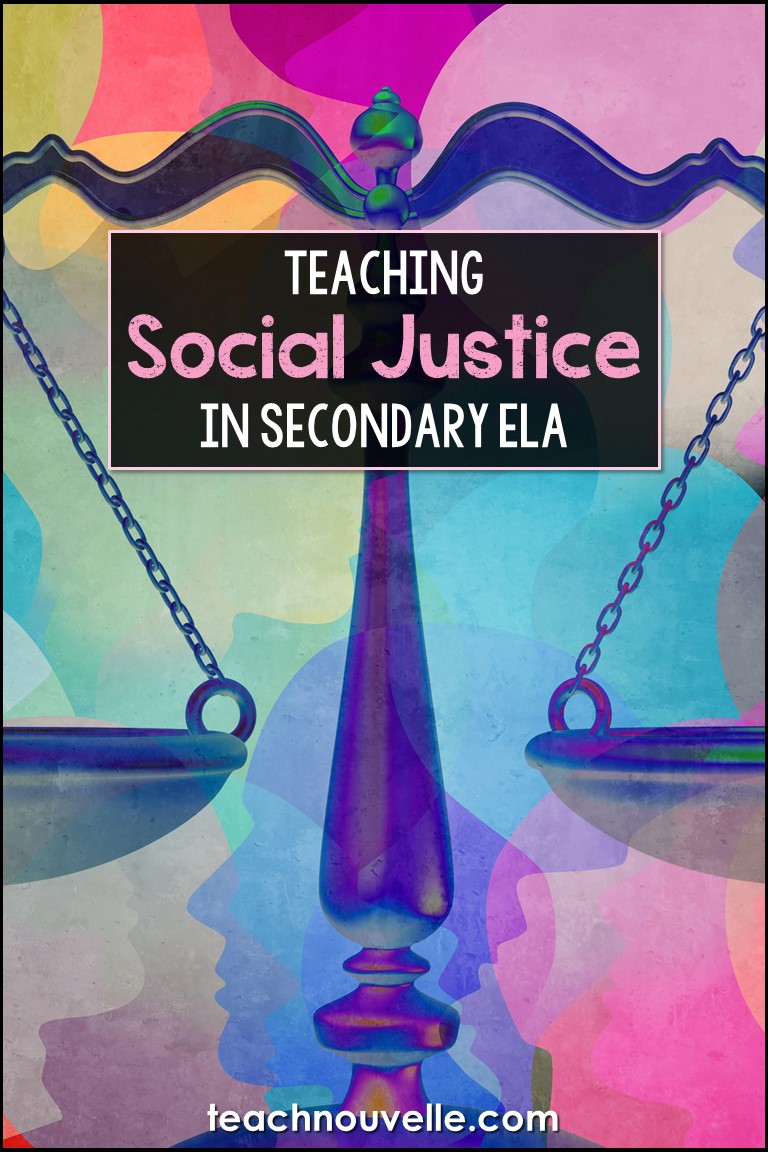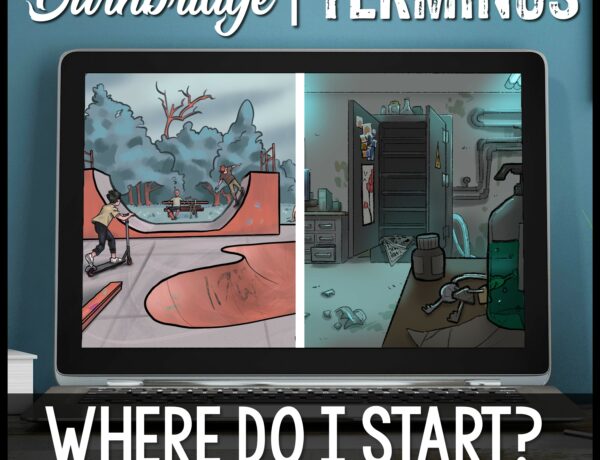Do you want to be teaching social justice in ELA but you don’t know where to start? Check out these tips, resources, and low-prep projects.
The title of this post is a bit misleading. Social Justice is part of teaching about our society and culture, and that is our principal work as ELA teachers. Our tools of choice are stories and communication, and we can interweave those in the goals of social justice.
What is Social Justice?
Social Justice is the acknowledgement of disparities in wealth and opportunities in our society based on race, class, gender, sexuality, and ability and an engagement in the effort to decrease those disparities. Therefore, developing an ad campaign to raise awareness about childhood poverty? Social justice. Writing an argumentative essay about why the town library should be wheelchair accessible? Social justice. This is political, but not partisan, and it is absolutely the domain of ELA teachers to share it with students.
Tips for Teaching Social Justice in ELA:
-
Justice is in your standards.
The biggest message I want to send today is that this is not an either/or situation. It’s not standards vs. diversity, or analyzing literature vs. talking about the issues. We can do both. Teaching Social Justice can be just as rigorous as teaching a “classic text.” Many Common Core standards are foundational to teaching Social Justice in ELA. Additionally, many students will find it easier to connect to read issues than fictional ones.
Reading a nonfiction article about an important issue? You can apply any standard from CCSS. ELA-LITERACY. RI.9-10.1 through CCSS. ELA-LITERACY. RI.9-10.6. Watching/listening to a political debate? CCSS. ELA-LITERACY. SL.9-10.3. Discussing issues with their peers? CCSS. ELA-LITERACY. SL.9-10.1.
Another incredible tool is Teaching Tolerance’s Social Justice Standards. They provide straightforward ways to measure student’s ability to understand and react to injustice. From K-2 (“I know everyone has feelings, and I want to get along with people similar to and different from me.”) to high school (“I can explain the short and long-term impact of biased words and behaviors and unjust practices, laws and institutions that limit the rights and freedoms of people based on their identity groups.”)
-
Integrate different perspectives and voices throughout your curriculum
Representation matters, y’all. According to projected numbers from the 2020 Census Bureau, most children living in the United States are students of color. In order to best meet the needs of all learners, it’s critical that students see themselves reflected in the works presented to them. Research shows readers make meaning and build knowledge when engaging with texts that they can relate to. Students have their very existence affirmed when they read texts written by and about people from their own culture, religion, orientation, etc. They learn their voices matter and that their stories secure an important place within the larger human experience. Books also have the power to serve as windows, exposing students to lives that may differ from their own, leading to increased empathy instead of increased apathy.
Find more actionable steps towards diversifying your curriculum here.
Even if your list of required texts is 100% dead White guys (more on that later!) you can provide supplemental materials to bring in some diversity. Many teachers are working to diversify their curriculum to include more voices. I’ve been working with Dr. Sheila Frye (from Teaching Literacy) on a project called “Rethinking the Classics” to help teachers find supplemental texts and curriculum updates. So far, we have covered The Giver, The Odyssey, The Outsiders, Romeo & Juliet, To Kill a Mockingbird, and The Great Gatsby, and we have many more to come.
Do you have a specific required text that you’d like to make more inclusive? Reach out to me @nouvelle_ela and I’ll see if I can help 🙂
-
Teach students to look for justice everywhere
Teach students to think critically about the media they consume. You can start with the list of required reading for your school. Whose voices are being heard? What perspectives are missing? Have students brainstorm a list of books that could replace core texts and make the curriculum more inclusive.
Based on this, students will learn to apply a critical lens to news stories, television, movies, etc. You might be familiar with the Bechdel-Wallace Test, a measure of the characterization of women in fiction. Different groups have proposed or developed other tests inspired by the Bechdel Test, like the Native Bechdel Test and the Race Bechdel Test. (These are just tools. No single test can determine something’s total worth, and a piece of media can “pass” a test while still being problematic.)
I also recommend sharing the Every Single Word project with your students. Its creator Dylan Marron produces supercuts of blockbuster movies, but only the words spoken by actors of color. The entire Harry Potter franchise video is 6:18, ET is seven seconds, and Jaws is even worse.
-
Include intentional discussion about Social Justice
When teaching Social Justice in ELA, it’s vital to carve out time for students to dialogue. One way to do this is through a Social Justice Lit Circle. Students will probably have some powerful reactions to the content. Black and POC students might feel triggered, and White students might experience White fragility when confronted with the harsh realities of racial injustice. Worried about the discussion staying calm and civil? You can check out these 10 tips for facilitating a respectful classroom on sensitive issues. Then, you and your students can work together to set out rules and expectations for classroom discussions (CCSS. ELA-LITERACY. SL.9-10.1. B)
You could also make time for these kinds of discussions in response to current events. On the blog myself and nine other ELA teachers share our tips for covering current events in the classroom.
I think that many kids instinctively get the concept of fairness, and with our support, they can tackle tough issues like systemic racism. Using a Lit Circle is a great way to dig into a complex issue.
One way I implement social justice lit circles in my classroom is when I teach Black History. While it’s important to celebrate the achievements and legacies of Black Americans from all walks of life, it’s also important to recognize that we have not yet realized Dr. King’s dream of equality. Teaching Black history means taking an honest look at how far we’ve come, and how far we still have to go. Students discuss Black Lives Matter, current research, and more in their lit circles.
This article by a first-grade teacher shows how he connects the dots from Civil Rights era history all the way up to BLM’s mission today. Naomi O’Brien from @readlikearockstar has an amazing video about teaching elementary students about racism. Students aren’t “too young”, as long as our approaches are developmentally-appropriate.
-
Give students a platform
Part of teaching your students that their voice matters is teaching them how to amplify that voice. Depending on what grade(s) you teach, your students are likely active on social media. Gen Z is already using social media to influence politics in ways that are groundbreaking and surprising. But that doesn’t mean they can’t learn from you. Have your students explore other ways expressing themselves, like writing to their elected officials. You could even have a “letter writing workshop” in your classroom! Have students find their elected officials and then read these tips from the ACLU on writing an effective letter or email.
Composing an op-ed, or a letter to an editor can be a great way to practice argumentative writing. It’s also a great way to get students thinking locally. Brainstorm some local issues students are concerned about. Do they have a potential solution? Is there an issue they feel isn’t getting enough attention? Have them share their concerns with the local paper instead (or in addition to!) posting about it on social media. (CCSS. ELA-LITERACY. SL.9-10.4) Remind them that if they expand their medium, they will broaden their audience.
Bonus tips for teaching social justice in ELA:
✨ Boost your student’s media literacy
Media literacy is vital for everyone. Your students might see themselves as masters of social media, but they can still fall prey to “fake news” and bot accounts posing as real people. I recommend having students take the Clemson University quiz, Spot the Troll, after you’ve taken it yourself, of course! This can be an individual activity, or you and your students can share your results and have a classroom discussion about it. What tactics were the troll accounts using? Were you more likely to trust an account that was posting views you agreed with? How are these false stories and bot accounts influencing the social media experience? (CCSS. ELA-LITERACY. SL.9-10.3)
✨ Teach the REAL history of BIPOC communities YEAR-ROUND
Don’t just teach Black history in February, Latine history in Latine Heritage Month, etc. Teaching BIPOC history is teaching American History and World History, and learning it helps everyone develop a sense of empathy, community, and empowerment. It places value on all individuals, ideas, and accomplishments. We owe our students more than a single story.
Additionally, be sure to avoid the too-often whitewashed version of history that silences injustices that can make white folks feel “uncomfy.” Example? I’ve got you covered.
Too many times, Dr. MLK Jr. is presented as a “dreamer,” but this is not the whole story. Black scholars have described this action as the “whitewashing” or “gentrification” of Dr. King. A 2018 think-piece in Essence describes it as a “willful decision to mis-characterize his person and work.”
I encourage you to reflect on the image of Dr. King that we are portraying to our students. As often as he mentioned loving and hoping, he spoke of struggling and fighting for justice. In “Letter from a Birmingham Jail,” he wrote, “We know through painful experience that freedom is never voluntarily given by the oppressor; it must be demanded by the oppressed.” If you’re ready to dig deeper, check out this piece from Medium.
✨ Celebrate BIPOC accomplishments
Ask yourself: Do your Black History Month lessons center on Black folks as the heroes of their own stories? #MoreOfThis. We have to give an honest picture of the injustices that have been/are being waged against Black Americans, but be careful not to position them as the victim in every story.
Be sure to check your resources to ensure they celebrate the accomplishments and cultural achievements of BIPOC communities when teaching social justice in ELA! For example, this mini-series with Henry Louis Gates, Jr. contains an excellent collection of primary and secondary stories celebrating Black Americans that are sure to engage and inspire your students.
✨ Avoid portraying monoliths
When teaching social justice in ELA or any BIPOC history to our students, it’s important to show that scholars, activists, and creators are not always united in their views. To suggest otherwise would portray a monolith that doesn’t exist.
Some more current examples? Consider Michael Eric Dyson and Cornel West. Or Spike Lee and Tyler Perry. They are arguably two of the most famous Black filmmakers, but they (and their art) are very different, and these differences have led to some verbal sparring in the press.
✨ Be mindful of simple accessibility tips
Even something as minute as encouraging movement in your classroom (which is immediately doable) can increase your accessibility for students. My rule is that they can get up from their desks (or work standing at the back counter), but the same standards of behavior apply for everyone.
Another movement suggestion? Halfway through our 45-minute lesson, we stop for a cross-body brain break. This two-minute activity can be touching a hand to the opposite knee or lifting a shoulder and opposite foot. When we cross the midline, we strengthen our physical intelligence and wake up the senses.
One more for the road: My favorite trendy activity is Escape Rooms. I love the collaboration and critical thinking aspect of these, but I also LOVE the movement! One way to add movement to any Escape Room is to hide clues throughout the classroom. Students are excited to look around and, moreover, this helps them burst their own desk “bubble”.
Final thoughts:
I hope this post has left you feeling excited and prepared for teaching social justice in ELA. How do you talk to your students about the tough topics? Do you have any favorite books or resources for addressing social justice issues? Comment below so we can all learn!
Stay connected with me on Instagram @nouvelle_ela. I’m constantly sharing tips and ideas from myself and other amazing members of “Teachergram.”







No Comments